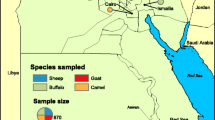Abstract
Serological prevalence of IgG antibodies against Rift Valley fever (RVFV) virus was investigated in 22 major localities in five different regions of Saudi Arabia where vaccination against RVF virus (RVFV) is not practiced. The study excludes the southwestern region where a major outbreak of RVF occurred in 2000 and where annual vaccination of ruminants is practiced. Sheep and goat IgG-sandwich ELISA were used to test serum samples from sheep and goats, and bovine IgG-sandwich ELISA was used to test cattle sera. A nonspecies-specific, nonantibody isotype-specific ELISA was used to test camel sera. A total of 3,480 sheep, goats, cattle and camels with no previous history of vaccination against RVFV were randomly tested. All tested animals were negative for IgG class antibodies against the virus except four out of 1,508 sheep and three out of 913 goats, which tested positive. All animals were clinically normal and no evidence was found of virus activity in the studied areas. It is, therefore, most likely that those rare positive cases, which constituted 0.002% of the total animals tested, were either false positives or vaccinates smuggled from the outbreak zone. The need for regular monitoring of animals both within the outbreak zone of 2000 and other parts of the kingdom is strongly emphasized.

Similar content being viewed by others
References
AL-Afaleq, A.I., E.M.E. Abu-Elzein, S.M. Mousa and A.M. Abbas, (2003). Retrospective study on Rift Valley fever in Saudi Arabia. Rev. Sci. Tech., 22: 867–871.
Al-Afaleq, A.I. and Hussein, M.F. (2011). The status of Rift Valley fever In Animals in Saudi Arabia: A mini review. Vector-borne and Zoonotic Diseases, Vol. 11(12), P. 1531–1520.
Al-Qabati and Al-Afaleq. (2010). Cross-sectional, longitudinal and prospective epidemiological studies of Rift Valley Fever (RVF) in Al-Hasa Oasis, Saudi Arabia. Journal of Animal and Veterinary Advances 9(2), page 258–265
Anonymous (2007). Statistical Report; Saudi Arabian Ministry of Agriculture, Riyadh, Saudi Arabia.
Anyamba, A., Chretien, J.P., Small, J., Tucker, C.J., Formentry, P.B., Richardson, J.H., Britch, S.C., Schnabel, D.S., Erickson, R.L. and Linthicum, K.J. (2009). Prediction of a Rift Valley fever outbreak. PHAS 2009; 106: 955–959.
CDC. (2000). Outbreak of Rift Valley fever—Saudi Arabia, August–October, 2000. MMWR 2000a; 49: 905–908.
Daubney, R., Hudson, J.R. and Garnham, P.C. (1931). Enzootic hepatitis or rift valley fever. An undescribed virus disease of sheep, cattle and man from East Africa. J. Pathol. Bacteriol.. 34: 545–579.
Davies, F.G. and Nunn, M.J. (1998). Risk of Rift Valley fever from livestock imported into the Kingdom of Saudi Arabia from the Horn of Africa. Report for Food and Agriculture Organization, Rome.
Elfadil, A.A., K.A. Hasab-Allah and O.M. Dafa-Allah, (2006a). Factors associated with Rift Valley fever in South-West Saudi Arabia. Rev. Sci. Tech. Off. Int. Epiz., 25: 1137–1145.
Elfadil, A.A., K.A. Hasab-Allah, O.M. Dafa-Allah and A.A. Elmanea, (2006b). The persistence of Rift Valley fever in the Jazan region of Saudi Arabia. Rev. Sci. Tech. Off. Int. Epiz., 25: 1131–1136.
Fagbo, S. (2002). The evloving pattern of Rift Valley fever in the Arabian Peninsula. Annals of the New York Academy of Science, 969: 201–204.
FAO-EMPRES. Rift Valley fever: update on RVF outbreaks in Saudi Arabia and Yemen. Transboundary Animal Diseases (2000); 15: FAO, Rome.
Flick, R. and Bouloy, M. (2005). Rift Valley fever virus. Curr. Mol. Med., 5(8): 827–834.
Paweska, J.T., Burt, F.J., Anthony, F., Smith, S.J., Grobbelaar, A.A., Croft, J.E., Ksiazek, T. and Swanepoel, R. (2003,a). IgG-sandwich and IgM-capture enzyme-linked immunosorbent assay for the detection of antibody to Rift Valley fever virus in domestic ruminants. J. Virol. Methods, 113: 103–112.
Paweska, J.T., Smith, S.J., Wright, I.M., Williams, R., Cohen, A.S., Van Dijk, A.A., Grobbelaar, A.A., Croft, J.E., Swanepoel, R., Gerdes, G.H. (2003,b). Indirect enzyme-linked immunosorbent assay for the detection of antibody against Rift Valley fever virus in domestic and wild ruminant sera. Onderstepoort J. Vet. Res. 70, 49–64.
Paweska, J.T., Mortimer, E., Leman, P.A. and Swanepoel, R. (2005). An inhibition enzyme-linked immunosorbent assay for the detection of antibody to Rift Valley Fever virus in humans, domestic and wild ruminants. J. Virol. Methods, 127: 10–18.
Thrusfield, M., (2005). Veterinary Epidemiology. 3rd Edn., Blackwell, Ames, Iowa.
Acknowledgment
The researchers would like to thank King Abdul-Aziz City for Science and Technology (Project No. 3-23-WH) for their kind financial support.
Author information
Authors and Affiliations
Corresponding author
Rights and permissions
About this article
Cite this article
Al-Afaleq, A.I., Hussein, M.F., Al-Naeem, A.A. et al. Seroepidemiological study of Rift Valley fever (RVF) in animals in Saudi Arabia. Trop Anim Health Prod 44, 1535–1539 (2012). https://doi.org/10.1007/s11250-012-0100-x
Accepted:
Published:
Issue Date:
DOI: https://doi.org/10.1007/s11250-012-0100-x



